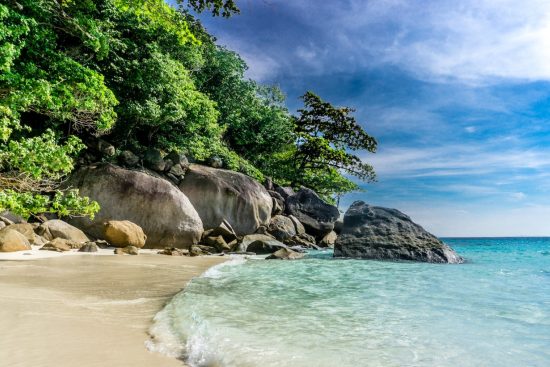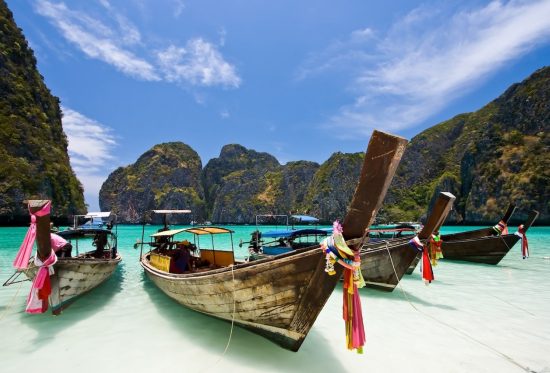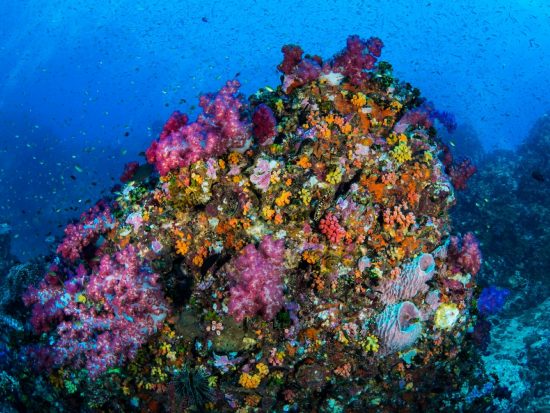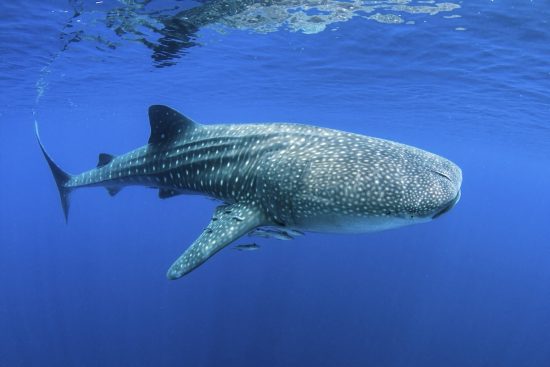







For budget-friendly tropical liveaboard diving and encounters with everything from ocean giants to tiny macro treasures, you can’t beat Thailand.
A much-loved dive destination for many years, Thailand offers dive sites for all experience levels, with stunning backdrops of forest-clad islands and sparkling turquoise seas.
Read on to discover Thailand’s 8 best dives.
North Andaman Sea
Similan Islands
One of the best-known Thailand diving destinations and ranked as one of the top dive destinations in the world, the Similan Islands are nothing short of epic.
Made up of 9 granite islands in the Northern Andaman Sea, these islands were declared a national park in 1982 and offer varied dive landscapes and vivid marine life.
You can find over 500 hard and soft coral species tucked among the huge boulders, caves, reefs and passages typically found at these impressive islands.
If you like pelagic action, you’ve come to the right place. Elephant Head Rock, the largest pinnacle in the Similans, is a challenging dive with strong currents that bring in whitetip reef sharks, trevallies and barracuda.
Macro fans won’t be disappointed with the abundant critters at Similan Islands dive sites, including ghost pipefish, mantis shrimps, pretty porcelain crabs and more.
Donald Duck Bay is a popular night dive spot where you’ll find plenty of macro treasures, including decorator crabs and emperor shrimps.
Koh Tachai
Lying between the Similan and Surin Islands, Koh Tachai might be small but it has two great dive sites; the plateau to the south and the eastern reef.
This small uninhabited island is covered in rainforest and has white sand beaches framing clear blue water.
Dive in and you’ll discover shallow waters perfect for snorkelling close to shore, plus sudden drop-offs plunging to 70m depth.
Koh Tachai Plateau has a coral plateau topped with hard corals and surrounded by snapper, plus gorgonian sea fans among the impressive boulders.
Be sure to look on the sandy bottom for zebra and nurse sharks resting there or peer closely for octopi among the corals and banded sea snakes.
Koh Tachai Pinnacle is a fun drift dive in plankton-rich waters, which attract manta rays and whale sharks.
Strong currents also draw numerous barracuda, trevallies and other sharks to this dive site.
Koh Bon
This isolated island among the Similans is exposed to the elements and offers two of Thailand’s best dives; Koh Bon Ridge and Koh Bon Pinnacle.
Being less popular than the surrounding islands, it’s a great spot to escape the dive crowds and surround yourself with abundant marine life.
The steep drop-off at Koh Bon Ridge is covered in clams, anemones and soft corals, making it a perfect spot for critter hunting.
As well as pipefish and mantis shrimps, you’ll find frogfish there.
Koh Bon Pinnacle is more exposed and is another great dive site for coral-covered walls, critters and also passing eagle rays.
Just make sure you look to the blue at either dive site, as they’re known for manta ray encounters.
Surin Islands
The idyllic and peaceful Surin Islands are a world away from modern life, offering National Marine Park diving with granite outcrops and pristine coral reefs.
Still relatively untouched and remote, they’re best accessed by Surin Islands liveaboard diving.
Reef sharks and barracuda are regularly seen cruising by the reefs and there are plenty of macro treasures to find, including frogfish, seahorses and jawfish.
Larger species found there include bumphead parrotfish, Napoleon wrasse, manta rays and whale sharks.
The Bon Soong Wreck is a popular dive in the area. This former old tin dredger sank in 1985 and is at just 20m depth.
An easy wreck dive with minimal currents, you’ll find tiny juvenile reef fish there, plus nudibranchs, scorpion fish and ghost pipefish around the wreck.
Just remember to take your camera to Bon Soong for those perfect images of schooling pelagics in the blue.
Richelieu Rock
Lying southeast of the Surin Islands, this world-famous dive site is known for its diversity of marine life and upwellings of plankton.
Changing currents and its exposed nature make Richelieu Rock best for advanced divers but the rewards are well worth it.
The central limestone pinnacle is covered in shelves and ledges, with coral-filled cracks and abundant soft coral fields.
Dive deep for black coral bushes and Gorgonians or stay shallow and surround yourself with thousands of glassfish.
As you descend, you’ll find huge schools of trevallies, barracuda, dogtooth tuna and more.
But the real highlights for any diver are the whale sharks and manta rays that visit this special dive spot from February to April each year.
Top North Andaman Sea liveaboard: The Sea World I liveaboard caters to just 18 guests and explores some of the best North Andaman dive sites, as well as the Mergui Archipelago in Myanmar.
South Andaman Sea
Hin Daeng
Hin Daeng is a popular dive spot in the Mu Koh Lanta National Marine Park. Some divers argue this dive site is as good as Richelieu Rock but with fewer divers in the water.
Offering a steep drop-off to 70m covered in hard and soft corals, there are abundant fish and macro life to find.
Shallower walls on the eastern and northern sides host schools of pelagics and passing reef sharks.
Be sure to keep your eyes open for marbled whip rays on the sandy flats wherever you dive.
Currents can be strong at Hin Daeng, making it best for experienced divers, but the many small inlets, canyon formations and rocky bays offer some shelter.
Whilst it’s a popular spot for cave diving with great visibility, when the visibility drops and plankton blooms, feeding whale sharks and manta rays arrive (February to April).
Hin Muang
Just a few hundred meters west of Hin Daeng, Purple Rock or Hin Muang is another top southern Andaman Sea dive site.
Aptly-named, the dive site is swathed in pink and purple soft corals and offers challenging dives among numerous rocky landscape features.
The channel in the middle of the reef is a great place to find plenty of reef fish hiding from the currents and you’ll also see schooling pelagics in the blue.
As an important feeding station for mantas and whale sharks, you’ll find them at Hin Muang from February to April.
Phi Phi Islands
The Phi Phi Islands are ideal for new and advanced divers alike, offering the chance to discover great dive sites without needing to be very experienced in the water.
Famous for their plunging limestone walls, the islands also offer fringing coral gardens, caves, caverns and swim-throughs – all within a small area.
Be sure to dive the King Cruiser wreck on your way to the Phi Phi Islands. This advanced dive is at 30m depth and the wreck is now a thriving artificial reef.
Top South Andaman Sea Liveaboard: The Whale liveaboard offers 4 to 5-day safaris in the southern Andaman Sea, making it ideal for a short diving getaway.
This article was written by divers and writers at LiveAboard.com
 LiveAboard
LiveAboard 20th December 2019
20th December 2019